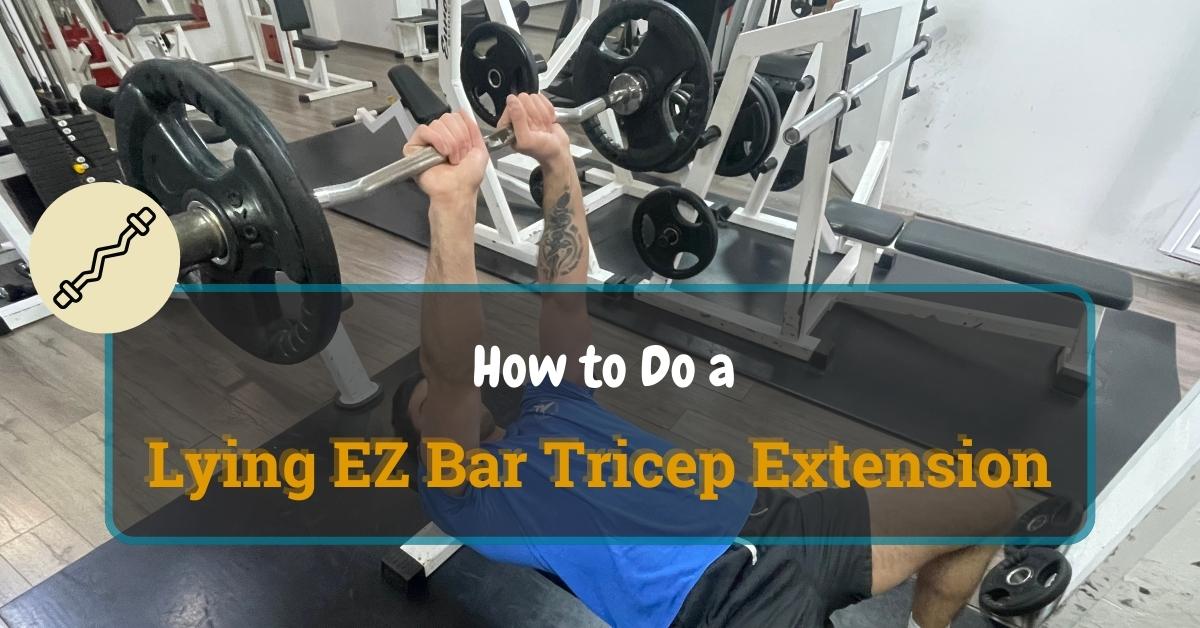The lying EZ bar tricep extension r is one of the most common tricep exercises. It is in many people’s weekly workout plans. Some of the reasons are its iconic name and, of course, its effectiveness. It is and was used by many professionals such as Rich Piana, Arnold Schwarzenegger, and Ronnie Coleman.
Table of Contents
ToggleThey are all great bodybuilders and recognize a functional exercise that builds not only strength but also muscle because of isolation. It provides the position of the skull crusher (position of the body and weight).
The iconic name comes from the movement where the load is lowered towards your face while lying down, so it looks like it’s almost crushing your head.
Let’s start with a simple guide about performing skull crushers correctly, and then we can jump into some tips, mistakes, and alternative exercises.
Start Building Your Dream Body Today
Ready to elevate your fitness game without falling into the trap of dull, repetitive routines that just don’t deliver? Imagine sculpting your ideal physique and boosting your health, all while still enjoying life’s pleasures, like those irresistible weekend getaways and your aunt’s legendary cheesecake. With our online fitness and nutrition coaching service, you don’t have to compromise. Dive into a personalized fitness journey that blends perfectly with your lifestyle, not against it. Book your completely free discovery consultation today, and take the first step towards a transformation that doesn’t require giving up the joys of life.

“I was skeptical about online fitness coaching, but Functional Body Savage completely changed my perspective. Vanja and Radomir’s personalized approach and attention to detail have helped me achieve goals I never thought possible. I’m stronger, more confident, and grateful for their guidance.”
Emily Thompson, San Francisco, CA
Learn More About Our Online Coaching ServiceQuick Summary
- Lying an EZ bar tricep extension or a skull crusher is a very effective and popular tricep exercise that targets all the heads of the tricep.
- It is beginner-friendly, and you can do it with lighter weights if you are strong enough (and preferably have a spotter) with heavier weights.
- The EZ bar is more joint-friendly and helps you develop the long head of the triceps more effectively.
- Some other exercises you can try that target triceps are dumbbell skull crushers, standing EZ bar overhead tricep extensions, dumbbell tricep press, and tricep rope pushdown.
How to Do a Lying EZ Bar Tricep Extension (Skull Crusher)
Here’s how to do the Lying EZ bar tricep extension.
Step One — Assume the Lying Starting Position
Start by lying down on a flat bench with your back fully rested against it. Make sure your feet are planted firmly on the ground for stability. Grip the EZ bar with an overhand grip, hands shoulder-width apart or even narrower, depending on your personal preference. Extend your arms straight up toward the ceiling, holding the bar directly above your chest.

Pro Tip: Maintain a stable and controlled posture throughout the exercise. Keep your elbows slightly bent to engage your triceps effectively.
Step Two — Lower the EZ Bar to Your Forehead
Have stable upper arms while you are lowering the EZ bar toward your forehead with controlled motion. Avoid contact with the forehead, focusing on a slow descent to effectively target the triceps while preventing strain.
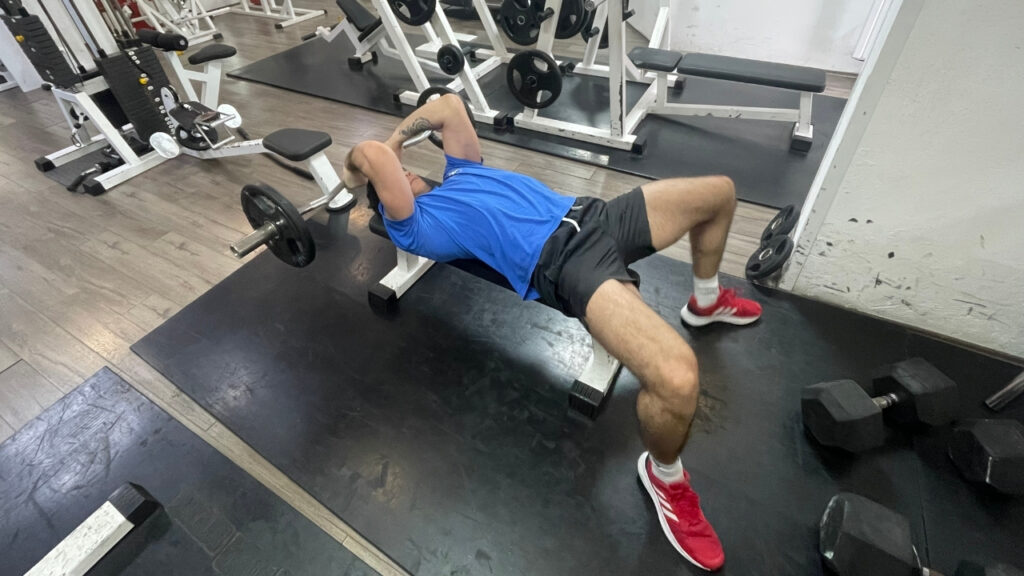
Pro tip: Control the motion by visualizing a smooth and deliberate movement. This not only maximizes triceps engagement but also minimizes the risk of overextending the elbow joint.
Step Three — Extend Your Elbows
Carefully extend your elbows, pushing the EZ bar back to the starting position above your chest. Fully engage your triceps during this upward movement, and make it as smooth as possible with controlled motion for optimal muscle activation and safety.

Pro tip: At the top of the movement, squeeze your triceps and pause for a second. This enhances the effectiveness of the exercise by maximizing time under tension, promoting muscle growth, and refining your mind-muscle connection.
Lying EZ Bar Tricep Extension Muscles Worked
The lying EZ bar tricep extension primarily targets the triceps brachii muscles, with secondary engagement of the anconeus and other stabilizing muscles in the arms and shoulders.
What Are the Benefits of EZ Bar Skull Crushers?
Down below are the benefits of the skull crushers that stand out.
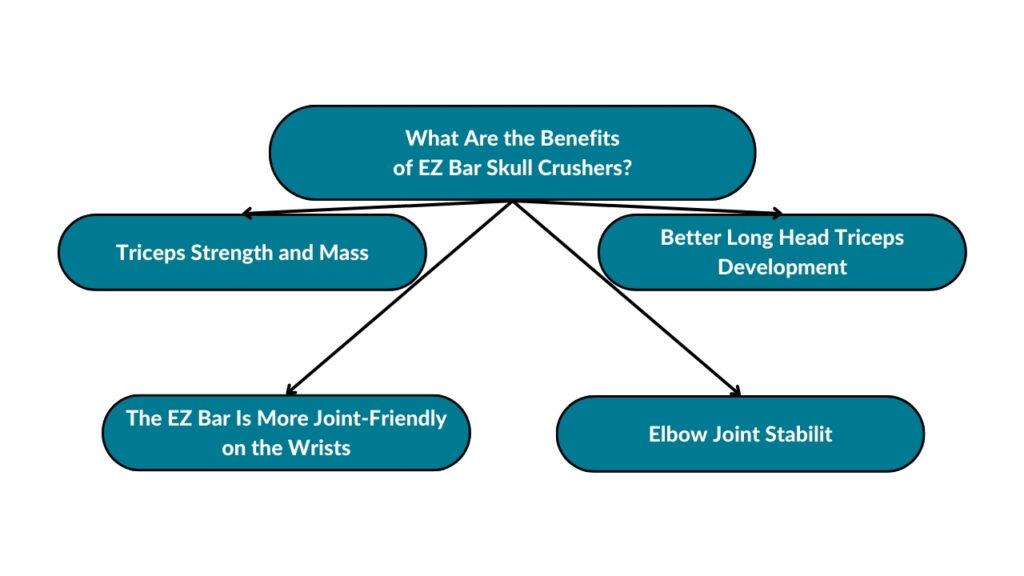
Triceps Strength and Mass
Skull crusher isolates the triceps from the rest of the body, which enhances the gains in strength and mass. It offers a very big growth potential in size and strength. By adding weight gradually, it’s easy to build strong and big triceps in a relatively short period of time.
The EZ Bar Is More Joint-Friendly on the Wrists
The EZ bar’s curved design gives us a more natural grip, which puts less pressure on the joints, allowing us to focus entirely on the triceps. This can be beneficial for individuals looking to minimize discomfort or wrist issues.
Better Long Head Triceps Development
As you lower the weight just above your forehead during a skull crusher, the long head of the triceps is put under increased tension, emphasizing its engagement. Over time, this targeted stress can lead to improved muscle growth and development, specifically in the long head of the triceps, contributing to a more balanced and sculpted appearance in the arm muscles.
According to one of the studies you can find on PubMed, triceps brachii muscle hypertrophy was substantially greater after cable elbow extension training performed in the overhead than neutral arm position, particularly in the biarticular triceps brachii long head, even with lower absolute loads lifted (i.e., lower mechanical stress to muscles/joints) [1].
Elbow Joint Stability
Performing skull crushers can contribute to enhanced elbow joint stability. This exercise engages the triceps while maintaining a fixed elbow position, promoting strength and stability in the joint. Also, avoid excessive weight to ensure the benefits without undue stress on the elbow joint and keep a proper form.
Tips
Here are the best tips for performing skull crushers.
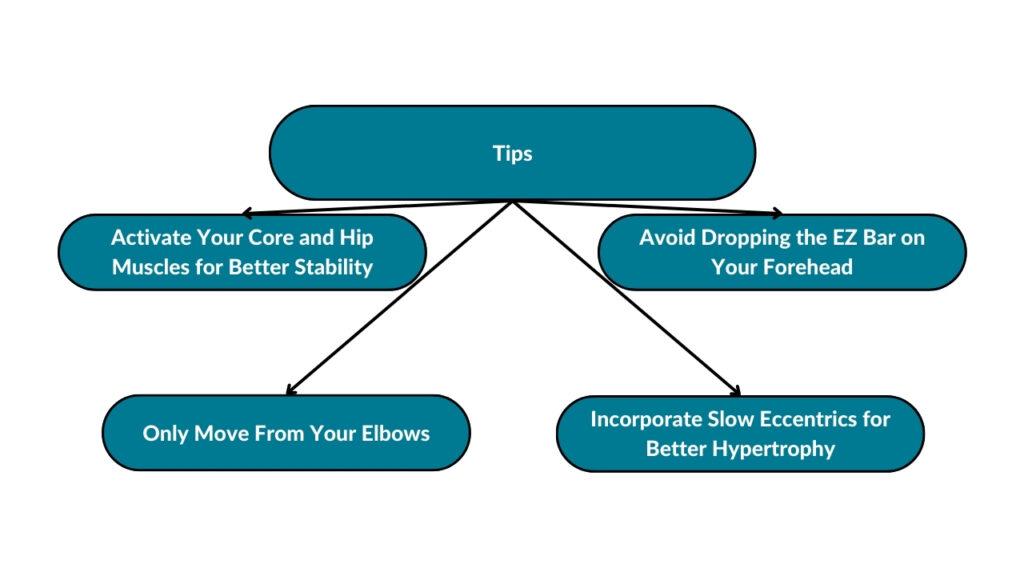
Activate Your Core and Hip Muscles for Better Stability
Engaging your core and hip muscles during the skull crusher will enhance your overall stability during the exercise. By maintaining a stable core and activating your hip muscles, you create a solid foundation for performing a skull crusher. This stability not only improves your form but also reduces the risk of unnecessary strain on the lower back.
Only Move From Your Elbows
Make sure only to extend your elbows and not move your upper arm. Moving your upper arm puts a load on your shoulders so that you won’t maximize the work of the triceps.
Avoid Dropping the EZ Bar on Your Forehead
Don’t rest by dropping the EZ bar on your forehead. Then you are not maximizing the work of the triceps, and of course, if you do it too often, you might develop a habit that puts you in danger when increasing the weight.
Incorporate Slow Eccentrics for Better Hypertrophy
Slow down the lowering movement; that way, you increase time under tension on the triceps muscles. This extended time under tension is associated with greater muscle fiber recruitment and can contribute to hypertrophy (which is the process of muscle growth).
Most Common Mistakes
These are some of the most common mistakes people make when performing skull crushers, which decreases the effectiveness of the exercise.

Flaring Elbows
Allowing the elbows to move outward away from the body while lowering the weight can place excessive stress on the shoulder joints and reduce the effectiveness of the triceps engagement.
Make sure to keep the elbows in a fixed position and pointed towards the ceiling throughout the movement, ensuring proper alignment and targeting the triceps effectively without compromising shoulder joint integrity.
Overextending the Elbows
If you overextend the elbows, you will feel discomfort or even get injured because it places excessive stress on the elbow joint.
To avoid this mistake, aim for a controlled extension without fully locking out the elbows. Keeping a slight bend ensures continuous tension on the triceps, promoting muscle engagement while minimizing unnecessary strain on the joints.
Using Too Much Weight
Using excessively heavy weights often leads to improper technique, making it difficult to control the movement and putting unnecessary strain on the elbows and shoulders. Other than that, it puts you in danger of dropping the weights on your head; it won’t even give you a good scar, so it’s not worth it.
The easy solution is always to use weight you are comfortable with, don’t ego lift, and if you really want to go heavy, have a spotter.
Not Controlling the Descent
Allowing the weight to fall on its own is quite common. Failing to control the descent can reduce the effectiveness of the exercise and increase the risk of injury.
Focus on controlled and slow eccentric movement, the lowering part of the skull crusher; this not only enhances muscle engagement but also reduces the likelihood of undue stress on the joints and surrounding muscles, promoting a safer and more effective skull crusher.
Lifting the Head
Lifting your head can lead to improper spinal alignment and potentially strain the neck, putting you in danger.
To avoid this mistake, keep your head firmly on the bench throughout the movement. Maintain a neutral spine position to ensure proper alignment, providing stability and reducing the risk of discomfort or injury to the neck and upper spine.
Keeping a steady head position also helps focus the effort on the triceps, optimizing the benefits of the skull crusher exercise.
Inconsistent Elbow Position
Often, changes in the position of your elbow can damage the effectiveness of the exercise. Allowing the elbows to move or flare out inconsistently during the exercise not only stops you from effectively targeting the triceps but also hinders joint integrity, form, and control during the skull crusher.
To fix this mistake, focus on keeping your elbows in a stable position throughout the entire range of motion. Make sure they point towards the ceiling and remain close to your body, maintaining proper alignment.
Consistent elbow positioning helps target the triceps effectively while minimizing stress on the shoulder joints for a safer and more efficient skull crusher.
Lying Ez Bar Tricep Extension Variations
Here are some variations of the exercise you can use instead of lying EZ bar tricep extension.
Dumbbell Skull Crushers
While the EZ bar’s angled grip can be more wrist-friendly and enable a fixed hand position, which makes it easier to maintain form, it also gives us a limited range of motion.
That’s why this variation, dumbbell skull crusher, gives us that versatility for targeting different angles of the triceps.
So, as we said, it gives us a greater range of motion, allowing for a deeper stretch and potentially greater muscle activation. Another good side is that each arm works independently, helping to address strength imbalances between sides.
On the other hand, it requires more stabilization, potentially making it challenging for beginners, and grip fatigue can occur during the exercise. Choosing between them might not be easy, but both of them are great options. Maybe use both of the variations; the decision is on you.
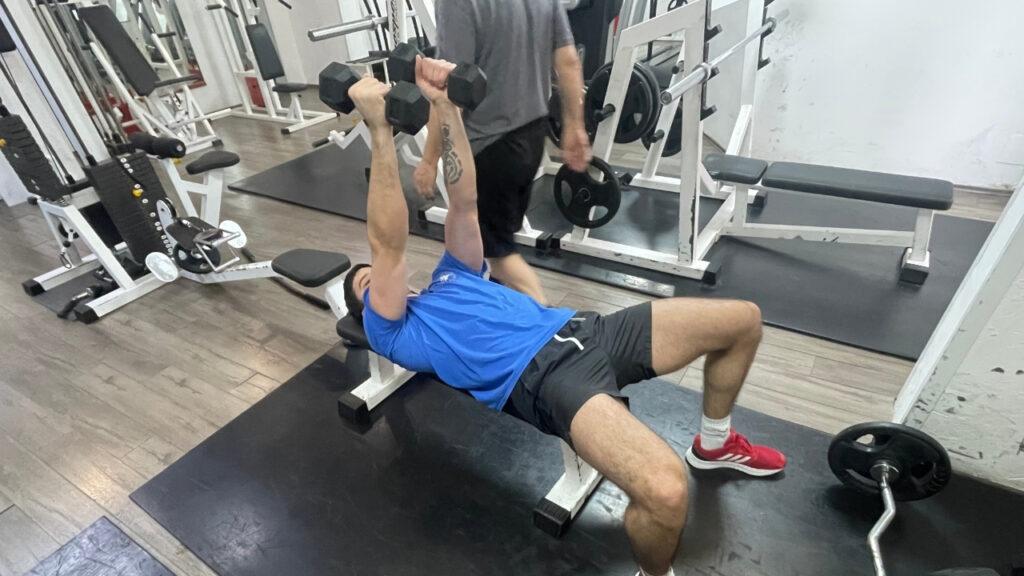
Either way, here’s how to perform dumbbell skull crusher:
- Lie on a flat bench with a dumbbell in each hand, held directly above your shoulders. Your palms should be facing each other, and your elbows should be slightly bent.
- Keeping your upper arms stationary, slowly lower the dumbbells toward your forehead. Your elbows should bend, and your forearms should move towards the floor.
- Hold for a short period, and then push the dumbbells back to the starting position and extend your elbows.
Pro tip: Focus on keeping your elbows stationary during the entire dumbbell skull crusher movement. Avoid letting your elbows flare outwards, as this can place unnecessary stress on the shoulder joints. Keeping a fixed elbow position helps isolate and target the triceps more effectively.
Straight Bar Skull Crushers
We already said that the pros of the EZ bar skull crusher are comfortability and less stress on the elbow, and the cons are a little bit less isolation and limited range of motion. Straight bar skull crusher gives us greater isolation and range of motion at the cost of wrist discomfort and elbow stress. While this sounds like trading a car for a horse, it’s not like that. They are both great choices, but picking which one to use is based on your preferences.
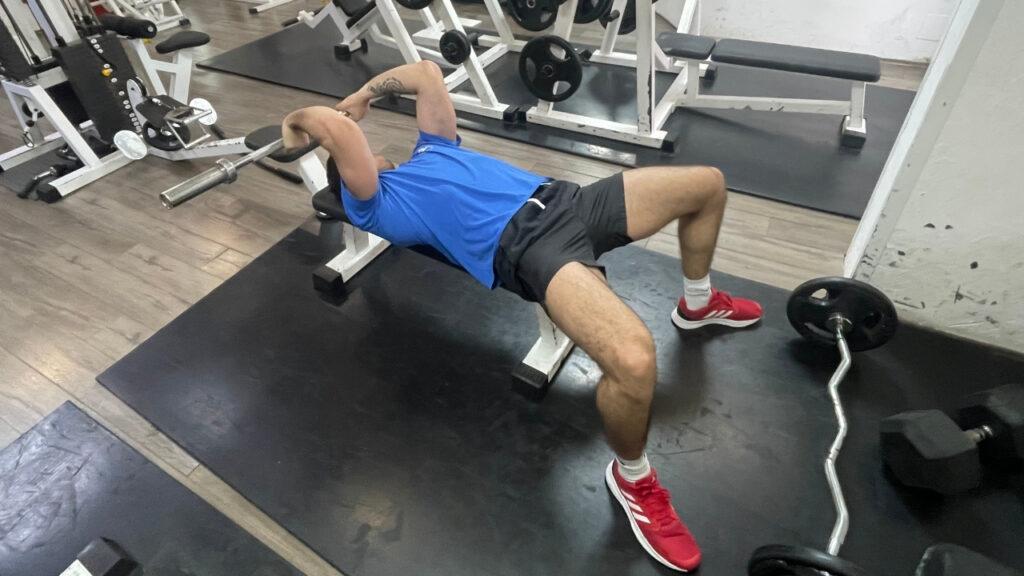
Here’s how to perform a straight bar skull crusher:
- Lie down on a flat bench with your feet flat on the ground. Grip the straight barbell with an overhand grip, hands slightly narrower than shoulder-width apart.
- Extend your arms fully, holding the barbell over your chest. Your elbows should be pointing toward the ceiling, and the barbell should be directly above your forehead.
- Keeping your upper arms stationary, slowly lower the bar towards your forehead by bending your elbows.
- Once the bar is close to your forehead, reverse the motion by extending your elbows to lift the bar back to the starting position. Fully extend your arms at the top, but avoid locking out your elbows to keep tension on the triceps.
Pro tip: Ensure that you maintain control and a steady pace as you lower the bar, maintaining a straight path.
Standing EZ Bar Overhead Tricep Extensions
This variation of the exercise gives us a full range of motion and involves stabilizing muscles due to the standing position, providing a more comprehensive workout. It may be less optimal for people who have shoulder mobility and lower back problems since it requires healthy shoulders and uses some lower back muscles.
Also, it is a little bit more difficult to perform it with a proper form, which is often a problem beginners have.

Here’s how to perform standing EZ bar overhead tricep extension:
- Stand with your feet shoulder-width apart and grasp an EZ bar with an overhand grip. Hold the bar with your hands slightly closer than shoulder-width apart.
- Lift the bar overhead, fully extending your arms. Keep your elbows close to your head, and ensure a firm grip on the bar.
- Lower the bar behind your head by bending your elbows. Keep your upper arms stationary. Lower the bar until your forearms are just past parallel to the floor.
- Extend your elbows to lift the bar back to the starting position, fully straightening your arms. Repeat for the desired number of repetitions.
Pro tip: Maintain a slight forward lean during the exercise. This not only enhances tricep engagement but also helps reduce strain on the lower back. Be sure to keep a straight spine and avoid excessive leaning, allowing for a controlled and effective movement that maximizes the benefits for your triceps.
Lying Ez Bar Tricep Extension Alternative Exercises
Here are a few alternative tricep exercises to do and add to your workout plan.
Tricep Rope Pushdown
Tricep rope pushdown emphasizes the lateral and medial heads of the triceps. Additionally, it engages the anconeus, a smaller muscle in the elbow region. It puts even less strain on the wrists and elbows and allows a lot of various hand positions.
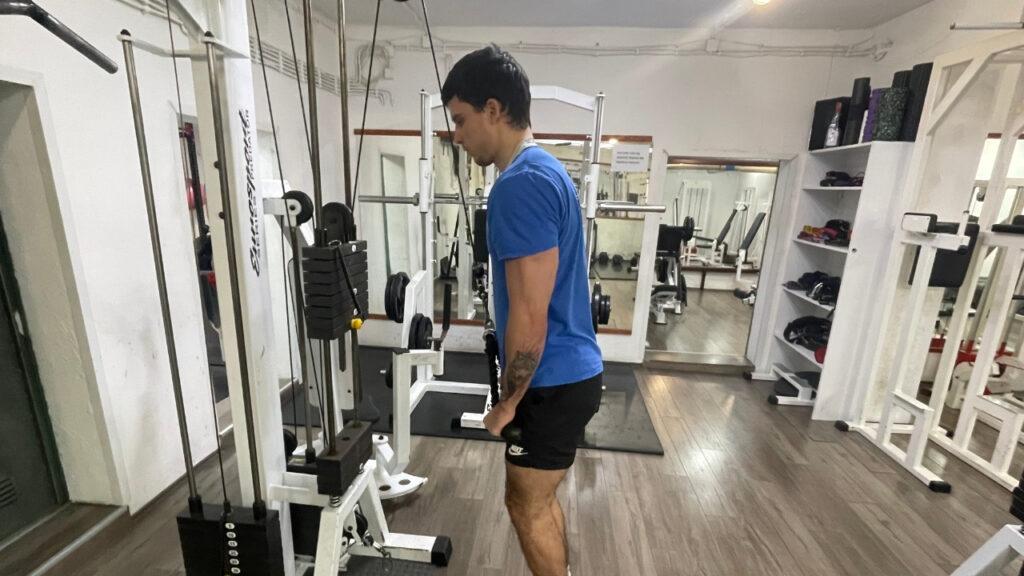
How to perform:
- Attach a rope to the high pulley of a cable machine. Stand facing the machine with your feet shoulder-width apart. Grasp the rope with a neutral grip (palms facing each other) and keep your elbows close to your sides.
- Positioning: Start with your elbows bent at a 90-degree angle and your upper arms close to your torso. Maintain a straight back and a slight forward lean from your hips.
- Initiate the movement by straightening your arms at the elbow. Focus on fully extending your arms while keeping your upper arms stationary. Squeeze your triceps at the bottom of the movement for maximum contraction.
- Slowly bend your elbows to bring the rope back up, controlling the resistance. Keep tension on the triceps throughout the entire range of motion.
Pro tip: Maintain tension and squeeze your triceps at the bottom of the tricep rope pushdown to enhance muscle activation and optimize your tricep workout.
Dumbbell Tricep Press
The dumbbell tricep press allows independent movement of each arm, addressing strength imbalances and ensuring each tricep works individually. Also, it offers a wider range of motion, engages stabilizer muscles, and is suitable for various fitness levels.
Having the right form is crucial for this exercise, so this is not a beginner exercise for most people.
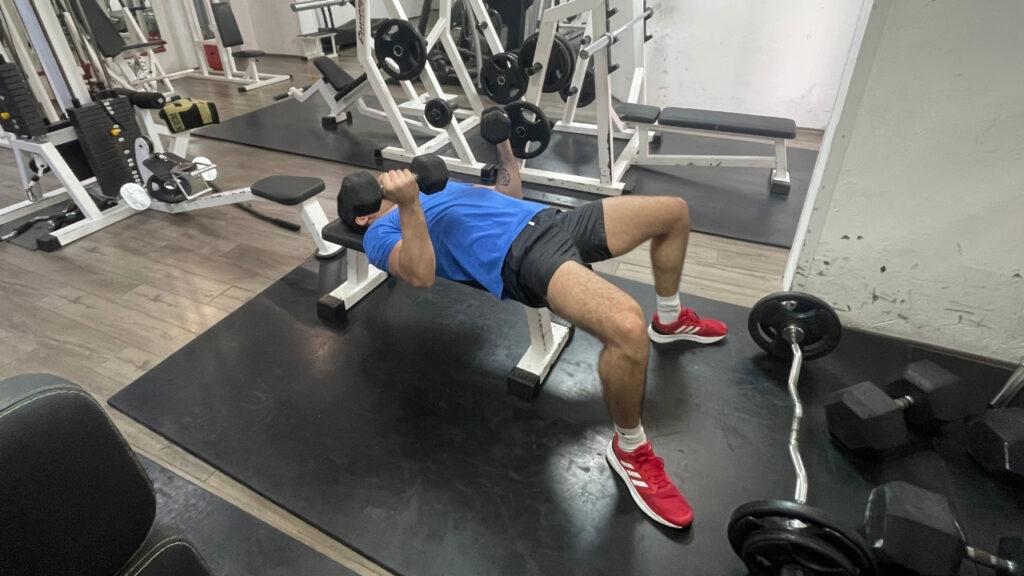
How to perform dumbbell tricep press:
- Lie on your back on a flat bench, holding dumbbells with a close, supinated grip just outside your body at chest level.
- Press the dumbbells vertically towards the ceiling, avoiding overextension of the elbows. Hold the top position briefly, focusing on controlled movement and preventing tricep relaxation.
- Pause just before full elbow extension, holding the top position for one second.
- Gradually lower the dumbbells to the starting position, resisting the urge to drop them right away. Try to have a three-second lowering phase to increase time under tension, ensuring proper form and minimizing injury risk.
Pro tip: To maximize tricep engagement, imagine pushing the dumbbells not just upward but also slightly inward, almost like pushing them toward each other. This adjustment enhances the contraction of the triceps and promotes well-rounded muscle development.
Single-Arm Dumbbell Overhead Tricep Extension
This exercise also gives us a wider range of motion and helps fight imbalances between hands. The imbalances are a common thing, so this exercise helps us strengthen our weaker arms.
The downside is a stability requirement; it requires good shoulder stability, and improper form may lead to discomfort and balancing challenges; for some people, it can be challenging to stay balanced while doing this exercise. Performing it while sitting may help those problems, but some are still stopped by balance.
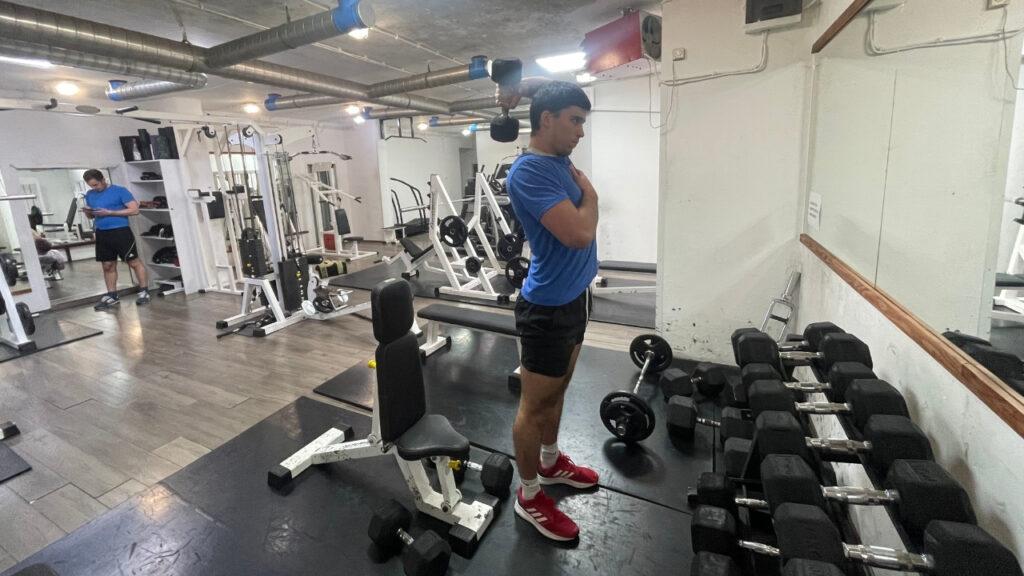
How to perform single-arm dumbbell overhead tricep extension:
- Stand with your feet shoulder-width apart. Hold a dumbbell with one hand and raise it overhead, fully extending your arm.
- Keep your elbow close to your ear, pointing upward.
- Lower the dumbbell behind your head by bending your elbow.
- Extend your arm back to the starting position, engaging your triceps.
Pro tip: Focus on maintaining stability by engaging your core. This not only helps prevent unnecessary strain on your lower back but also enhances overall balance, allowing you to target your triceps more effectively. Keep your core tight throughout the exercise to maximize its benefits.
FAQs
Is Lying Tricep Extension Good?
Lying tricep extensions are a highly effective exercise for building tricep strength, muscle mass, and definition.
What Is the Difference Between Lying EZ Bar Tricep Extension and Skull Crushers?
Lying EZ bar tricep extensions and skull crushers are basically the same exercise. The only difference between skull crushers and lying triceps extensions is that when you perform a skull crusher, you can lower the bar to your forehead, nose, chin, or behind your head.
Is the EZ Bar Better Than the Barbell for Tricep Extensions?
EZ bar is better than the barbell because an EZ curl bar is suitable for exercises that work on a smaller group of muscles, such as the triceps.
Are Tricep Extensions Safe?
Tricep extensions are safe. However, it’s important to use a weight where you can perform the movement controlled and with correct form, as having improper technique can stress the elbow and, of course, not banging the weights on your head.
Do Tricep Extensions Hit Long Head?
Tricep extensions hit all three heads, including the long head.
Do Tricep Extensions Make Arms Bigger?
Tricep extensions make your arms bigger because they build muscle, and triceps make up two-thirds of the arm.
Wrapping Up
Lying EZ bar tricep extension is an effective and popular tricep exercise. It targets all three heads of the tricep.
Using it as a primary exercise or as a secondary exercise will give you many benefits; it will effectively grow your triceps and prepare them for the real world.
With progressive overload and the right form, you will see changes in no time. Make sure to train consistently to maximize its effectiveness, just like any other exercise.
Start Building Your Dream Body Today
Ready to elevate your fitness game without falling into the trap of dull, repetitive routines that just don’t deliver? Imagine sculpting your ideal physique and boosting your health, all while still enjoying life’s pleasures, like those irresistible weekend getaways and your aunt’s legendary cheesecake. With our online fitness and nutrition coaching service, you don’t have to compromise. Dive into a personalized fitness journey that blends perfectly with your lifestyle, not against it. Book your completely free discovery consultation today, and take the first step towards a transformation that doesn’t require giving up the joys of life.

“I was skeptical about online fitness coaching, but Functional Body Savage completely changed my perspective. Vanja and Radomir’s personalized approach and attention to detail have helped me achieve goals I never thought possible. I’m stronger, more confident, and grateful for their guidance.”
Emily Thompson, San Francisco, CA
Learn More About Our Online Coaching ServiceReferences:
- Maeo S, Wu Y, Huang M, et al. Triceps brachii hypertrophy is substantially greater after elbow extension training performed in the overhead versus neutral arm position. Eur J Sport Sci. 2023;23(7):1240-1250. doi:10.1080/17461391.2022.2100279

